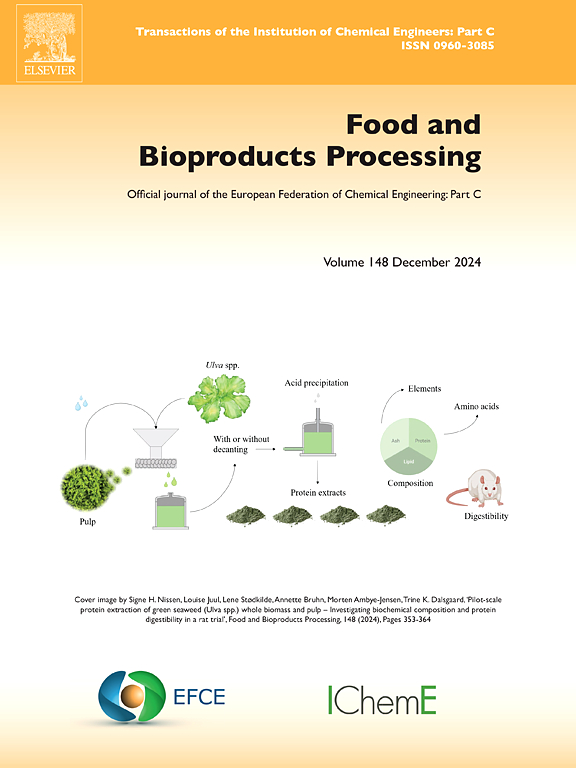Microencapsulating Lacticaseibacillus rhamnosus GG by spray drying using pea protein, pectin, and tapioca flour: Probiotic viability, digestibility and thermal stability
IF 3.5
2区 农林科学
Q2 BIOTECHNOLOGY & APPLIED MICROBIOLOGY
引用次数: 0
Abstract
This study aimed to develop an efficient route for the encapsulation of the probiotic Lacticaseibacillus rhamnosus GG by spray drying, using a combination of pea protein, pectin, tapioca flour, and maltodextrin as wall materials. For this purpose, five formulations were prepared with 5 % cell suspension: F1 (5 % maltodextrin, 5 % pea protein, 5 % tapioca flour, and 1 % pectin), F2 (10 % maltodextrin, 4 % pea protein, and 2 % tapioca flour), F3 (10 % maltodextrin, 2 % pea protein, and 4 % tapioca flour), and F4 (7.5 % pea protein, 7.5 % tapioca flour, and 1 % pectin). The microparticles were evaluated for encapsulation efficiency (EE), structural characteristics, thermal resistance, in vitro simulated gastrointestinal digestion, physical characteristics, and probiotic viability during storage. All samples exhibited EE values ranging from 88.76 % to 94.58 %, low moisture content (5.19–6.70 %), high solubility (78.55–85.26 %), and hygroscopicity below 10 %. The microparticles exhibited an amorphous nature and varied morphological aspects; F2 showed a smooth and uniform surface with slight irregularities, which possibly contributed to its effective encapsulation properties. In thermal resistance tests, F1 showed the highest viability at 80 °C for 5 min (65.95 %), while at 60 °C for 30 min, survival ranged from 43.92 % (F2) to 61.18 % (F1) (p < 0.05). The F2 stood out for its greater resistance and significant number of viable cells during the in vitro digestive process. After 7 weeks of storage at 8 °C and 25 °C, the F1, stored at 8 °C, maintained the highest cell viability at the end of the period (8.02 log CFU/g). These findings demonstrate that the specific formulations developed, particularly F1 and F2, offer enhanced thermal resistance, encapsulation efficiency, and storage stability, making them highly suitable for potential applications in the food and pharmaceutical industries as probiotic delivery systems.
用豌豆蛋白、果胶和木薯粉喷雾干燥微胶囊鼠李糖乳杆菌GG:益生菌活力、消化率和热稳定性
本研究以豌豆蛋白、果胶、木薯粉和麦芽糊精为壁材,建立了一种高效的鼠李糖乳杆菌GG喷雾干燥包封工艺。为此,配方是准备5 %细胞悬液:F1(5 %麦芽糊精、5 %豌豆蛋白,5 %木薯粉,和1 %果胶),F2(10 %麦芽糊精、4 %豌豆蛋白和2 %木薯粉),F3(10 %麦芽糊精、2 %豌豆蛋白质,和4 %木薯粉),和F4(7.5 %豌豆蛋白7.5 %木薯粉,和1 %果胶)。研究了微颗粒的包封效率(EE)、结构特性、耐热性、体外模拟胃肠消化、物理特性和储存期间益生菌活力。所有样品的EE值范围为88.76 % ~ 94.58 %,低含水率(5.19 ~ 6.70 %),高溶解度(78.55 ~ 85.26 %),吸湿性低于10 %。微粒子表现出无定形的性质和多样的形态特征;F2表面光滑均匀,凹凸不平,这可能是其有效包封性能的原因。在耐热性试验中,F1在80°C条件下存活5 min(65.95 %)最高,而在60°C条件下存活30 min,存活范围为43.92 % (F2)至61.18 % (F1) (p <; 0.05)。在体外消化过程中,F2表现出更强的抗性和大量的活细胞。在8°C和25°C保存7周后,8°C保存的F1在保存期末保持最高的细胞活力(8.02 log CFU/g)。这些发现表明,开发的特定配方,特别是F1和F2,具有增强的耐热性,封装效率和储存稳定性,使其非常适合作为益生菌输送系统在食品和制药行业的潜在应用。
本文章由计算机程序翻译,如有差异,请以英文原文为准。
求助全文
约1分钟内获得全文
求助全文
来源期刊

Food and Bioproducts Processing
工程技术-工程:化工
CiteScore
9.70
自引率
4.30%
发文量
115
审稿时长
24 days
期刊介绍:
Official Journal of the European Federation of Chemical Engineering:
Part C
FBP aims to be the principal international journal for publication of high quality, original papers in the branches of engineering and science dedicated to the safe processing of biological products. It is the only journal to exploit the synergy between biotechnology, bioprocessing and food engineering.
Papers showing how research results can be used in engineering design, and accounts of experimental or theoretical research work bringing new perspectives to established principles, highlighting unsolved problems or indicating directions for future research, are particularly welcome. Contributions that deal with new developments in equipment or processes and that can be given quantitative expression are encouraged. The journal is especially interested in papers that extend the boundaries of food and bioproducts processing.
The journal has a strong emphasis on the interface between engineering and food or bioproducts. Papers that are not likely to be published are those:
• Primarily concerned with food formulation
• That use experimental design techniques to obtain response surfaces but gain little insight from them
• That are empirical and ignore established mechanistic models, e.g., empirical drying curves
• That are primarily concerned about sensory evaluation and colour
• Concern the extraction, encapsulation and/or antioxidant activity of a specific biological material without providing insight that could be applied to a similar but different material,
• Containing only chemical analyses of biological materials.
 求助内容:
求助内容: 应助结果提醒方式:
应助结果提醒方式:


